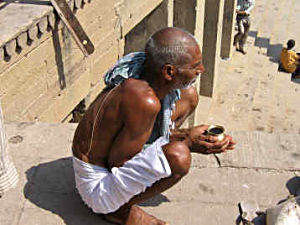
Impressions from a recent visit to Northern India

"How can one define India? There is no one language, there is no one culture. There is no one religion, there is no one way of life. There is absolutely no way one could draw a line around it and say, 'This is India' or, 'This is what it means to be Indian.'" (Arundhati Roy)
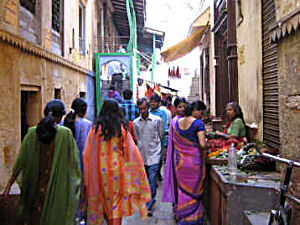
It couldn’t be said better. At first you are hit by a whirlwind of India’s charm, its people so full of life and friendliness, the beauty of the bright-eyed children and young people, the dignity of the women dressed in colorful saris, the impeccably dressed men in Kurta and Pajama, or more western style jackets and slacks, all the different aspects of the streets that are teeming with rickshaws, bicycles, cars, cows and people – all this takes your breath away when you first arrive in India.
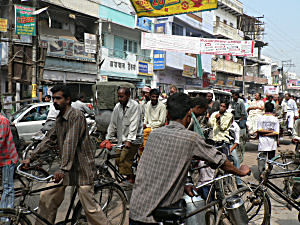
A typical street in the northern part of Varanasi
After some time, though, you might feel that seeing the daily and never-ending hardship of a huge part of the Indian population overpowers you with feelings of shame and disgust. I am of course mostly referring to the Dalit, also called the untouchables, because of the way the four castes (called Varna in a religious context) consider them unclean. The Dalits make up 20% of the Indian population and together with the lowest caste, the Sudra, they make up about half of the entire population. The Dalits are made to do all the dirty and polluting work there is, burn dead human bodies, deal with the animals, their hides and even their excrements, sweep and clean streets, deal with sewage and do various kinds of menial work. You can see them make patties from cow dung with their bare hands, for decoration and also to make fire when wood is scarce.
Quote from Adaniel’s Info Site: “Legally the government disallows the practice of caste system but has a policy of affirmative discrimination of the backward classes.”
The Dalits, men and women, are seen all over India working on road improvements – by hand, no machines being used, just rudimentary tools. They also live in segregated villages and sections on the fringes of cities and they are not allowed to enter the home of a caste person. They are, according to the law, allowed to go to school, but most poor people can not afford the school uniforms, the transportation and the various school paraphernalia that are necessary.
The boys and girls who do go to school are dressed in chic and comfortable-looking school uniforms, the girls with scarves around their necks, tied or crossed in front and tucked over their shoulders, as with saris, the boys wearing ties, neat shirts and long pants. It’s a wonderful sight seeing groups of these kids going to and from school, the boys often biking, the girls always walking in groups.
Dalit women, however menial their tasks are, are also dressed in colorful saris, even though they can not possibly be as clean as the ones the women in the cities wear in the crowded and buzzing streets. They carry heavy burdens, sacks and bricks on their heads, securing the load gracefully with one hand.
Their eyes are without any expression, they are dead eyes looking at nothing – from knowing that this will always be their lot. Nothing can ever give them hope for a change in their lives.
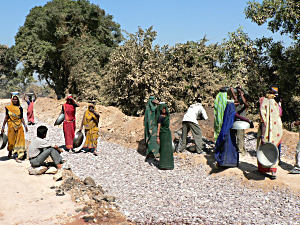
But also the lives of the poor millions who work as rickshaw drivers, bike rickshaws in particular, and in menial jobs depending heavily on tips for their survival, lead an almost subhuman life that is very hard for us Westerners to accept.
Unless you can really feel that you are doing something that can help them change something in their hard lives, I simply don’t understand how it is possible for Westerners to stand the sight of this extreme poverty and ruthless segregation for a long period of time without feeling shame and boundless pity. I can only guess how the British imperial lords before 1947 managed to live so happily in India. They were of course completely isolated from the daily lives of the regular Indian populace, the Dalits as well as the lower working caste, the Sudra, whom they most likely only saw as their servants. Members of this class are the peasants and working class of the society who work in non-polluting jobs. The Dalits work in degrading and polluting jobs, the Sudra work mainly in non-polluting jobs. Once again, you get more information from Adaniel’s Info Site.
The noise, the
life, the shops along the sides of the streets teeming with life, the
varied and bright colors, the piles of garbage in the streets that seem
to be eternally swept without ever getting clean, the markets with
stands overflowing with all possible things, from fruit and vegetables
to padlocks and tools, the dogs most of them roaming freely and mostly
not belonging to anyone, all too often actually looking mangy and
totally abandoned, the cows lying calmly vegetating in the streets,
being cleverly avoided by the rickshaws and cars. The garbage was swept
up in piles that were sometimes burned and cows were tranquilly
ruminating next to the goats that were wandering around in herds, most
often unattended.
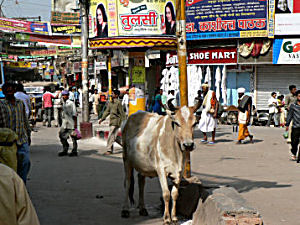
All this is so vibrant with life that it fairly takes your breath away. The noise and especially the honking of horns is continuous, only the cows are left alone. Nobody would dream of disturbing a cow. If this animal has decided to lie down in the middle of the street, so be it. There is always a way around the holy cow. The dark brown cattle with corkscrew horns are strictly speaking buffaloes, but they are just as holy as the cows, and more abundant. They have a very visible hump on their backs, right behind the neck and they look very different from cows anywhere else in the world.
Coping with the traffic is a very peculiar game of skill and constant awareness of what other drivers are up to. In India, you basically drive on the left side of the road, but that is just a rough rule. When a car or rickshaw is in your way, you pass on the left or on the right, wherever there is or you can make some room, whether you are in a city or on a country road. You are supposed to honk loudly before passing. Trucks and buses usually carry a reminder on the back saying BLOW HORN. And the streets always seem to be filled to overflowing with vehicles of all the different kinds, most of the trucks and buses looking ancient and ready for the scrap yard. The trucks are usually gaudily decorated in front with garlands, little lamps and tinsel.
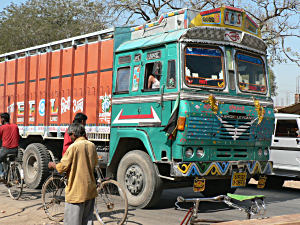
With its population of one billion, India is the second most populated country in the world (after China). This enormous subcontinent is the home of the most violent tensions in any so-called democracy in the world. Tensions between the dominant Hindu population and the Muslim minority, tensions because of the unspeakably cruel caste system, with the casteless Dalits at the bottom of the social scale, the casteless, the untouchables, the people with no rights; tensions between India, mainly Hindu, and Pakistan, predominantly Muslim and the continuous strife over the independent state of Kashmir, said to be the most beautiful place on earth, situated at the foot of the Himalaya Mountains.
Kashmir, the embattled state which is controlled by Pakistan in the west, by India in the southeast and by China in the north, the wonderful country at the foot of the great Himalaya mountains, used to be a place where people of different religions and ethnicities lived peacefully together. It has since been torn by big-power rivalries, a victim of colonialism.
The foundation of Pakistan as a country dates from the days immediately preceding the Independence of India on August 15, 1947. The Partition between India and Pakistan left both countries devastated after the catastrophic riots that took place on both sides, all based on religious fanaticism. 15 million refugees poured across the borders, in both directions, to regions completely foreign to them.
The caste system
Gandhi
also used an old and non stigmatizing name for the untouchables, a name
meaning God’s little children, Harijan in Hindi, and one of his
great goals was to bring about the abolishment of the cruel caste system in
India. It is obviously
very deeply rooted in Indian religious history and its culture and it
is questionable if it will ever be given up or even altered.
Even though the caste system was declared technically illegal through the Untouchability Act in 1955, there has been very little improvement in the lives of the Dalits. The stigmatizing of the Dalits is upheld by millennium-old tradition and way of life.
Quote from Combat Law - Editorial: 50 Years of Independence - still untouchable
“Despite the legal prohibition, even now hundreds of thousands of public wells and hundreds of temples all over the country are not accessible to Dalits.”
A Hindu is born into a caste and he remains in it, even though there are some examples of untouchables who have become highly educated and who fight for abandoning the caste system.
The political situation of the recent era
For
decades now, India has been ruled alternately by the Congress Party,
now the National Congress Party and the BJP, Bharatiya Janata Party,
until 1980 under the name of Bhartiya Jana Sangh, its most recent Prime
Minister: Shri Vajpayee. In 2004, the National Congress Party with
Sonia Gandhi as its major front runner, won the election over the
previously ruling Janata Party, to a great extent due to the massive
corruption rampant in the BJP.
In truth, however, India has under both parties, from the beginning, been among the most deeply corrupt nations in the world. Even Jawaharlal Nehru tolerated the prevalent corruption and his daughter Indira Gandhi (no relation of Mahatma Gandhi) institutionalized it. Sonia Gandhi, widow of Indira’s son Rajiv and Italian born, in spite of the electoral victory of her party, ceded the post of Prime Minister to Manmohan Singh.
Sonia Gandhi holds the post of President of the National Congress Party even though she very recently resigned from the posts of MP and President of the National Advisory Council. As she says, she became an Indian citizen the day she became Indira Gandhi’s daughter-in-law. She is, however, the target of some animosity because of her Italian origin, particularly of course from the opposing Janata Party. Among other things, through her extremely influential role in Indian politics, she has made important efforts to curb the vicious corruption that is prevalent in India. It remains to be seen now if she is going to keep her enormous influence in the Congress Party.
India and the free-market system
India is deeply in the grips of the neoliberal free-market system and thus, even if the growth rate has increased, it does not in any way imply that the fates of the rural people have improved. The truth is exactly the opposite. You only have to read an article or two by the outstanding novelist and political activist, the Delhi-based Arundhati Roy, to find out what the real situation is like. She says in an interview by Amy Goodman at Democracy Now concerning the recent visit by George W. Bush (which occurred exactly while we were in India)
“And yesterday on the streets, while I was there, there were, you know, 53 widows, from my state of Kerala, of farmers who have committed suicide because of the closing net of debt around them. Tens of thousands of farmers have committed suicide. And yet, you know, he arrived here with these corporates like ADS and Cogentrix and Unocal. All of them have such dubious records. It's really unbelievable, and yet if you see the way the CEOs and the corporates are falling over him -- and I have to mention this, that they couldn't find a public space in India for Bush to speak, so he ended up -- the meeting was organized in the Delhi zoo, in the walls of the Purana Qila, which houses the Delhi zoo, where he was going to speak to some rich people and some corporate people.”
Devinder Sharma says in a ZNet commentary from March 26, 2006:
“The Rs 10,000-million Indo-US Knowledge Initiative in Agricultural Research and Education, formally launched by the American President George Bush at Hyderabad in southern India on March 3, was more or less a soft launch of the second Green Revolution that brings Indian agriculture under the direct control of US Corporate houses. If the first Green Revolution was facilitated by the introduction of Land Grant system of agriculture research and education into India, the second Green Revolution is being tailored to the needs of the American agri-business interests.”
[…]
“Following the agreement, a team of Indian agricultural scientists visited US in December 2005 to work out the modalities of the programme. It was followed by a return visit by US agricultural scientists, and the entire exercise has been kept confidential and prepared in a hush-hush manner. The dominance of the American agri-business becomes clear when one finds the US supermarket giant Wal-Mart and the seed multination Monsanto on the board of the Initiative.”
Pushing Farmers Out of Farming by Devinder Sharma -
A must read at ZMag
© Copyright 2006 by AxisofLogic.com
Go to India: Part II